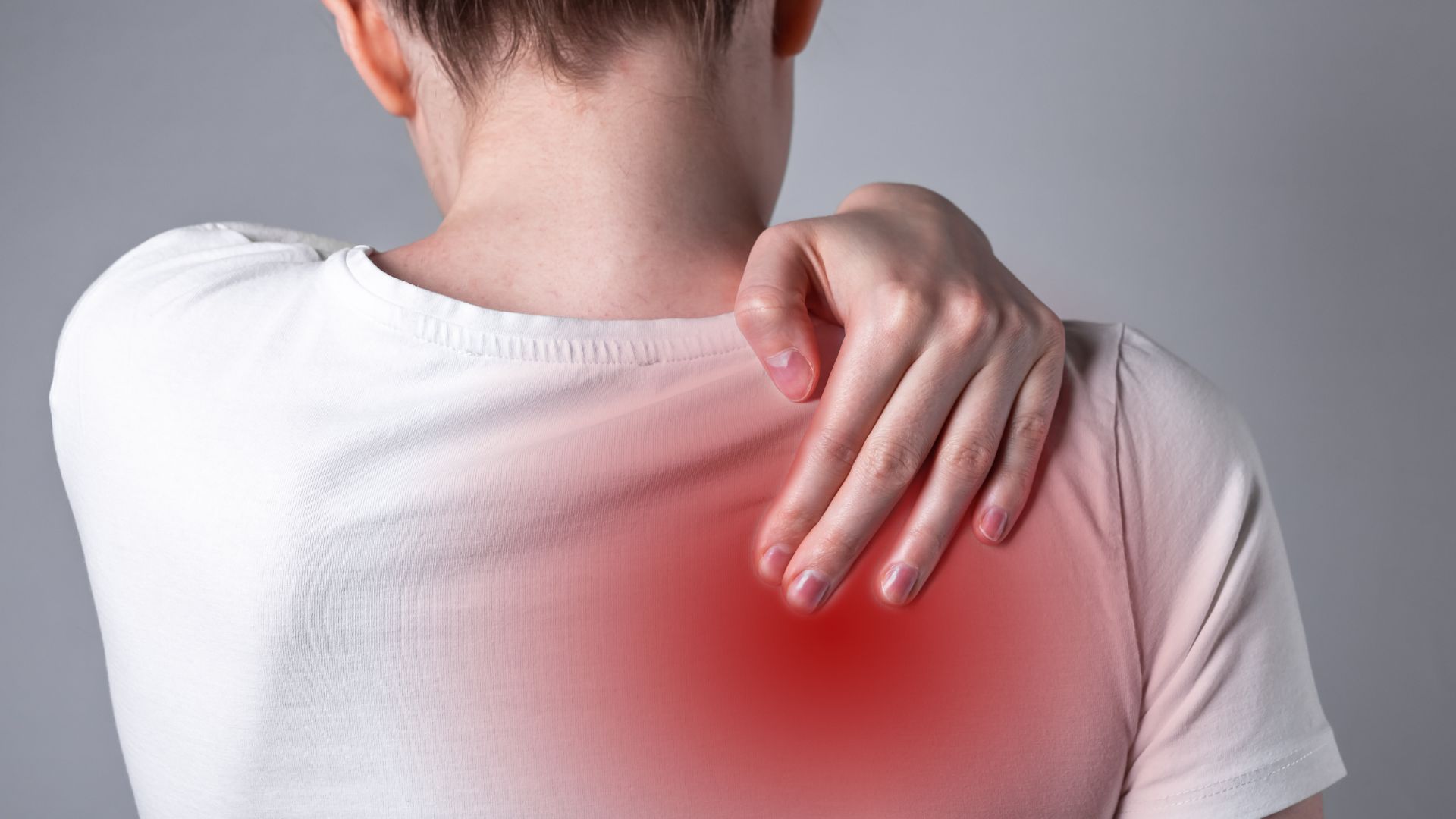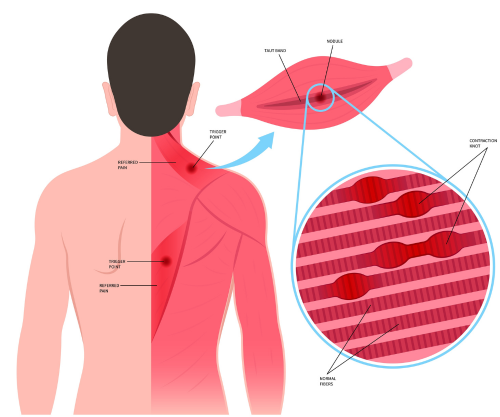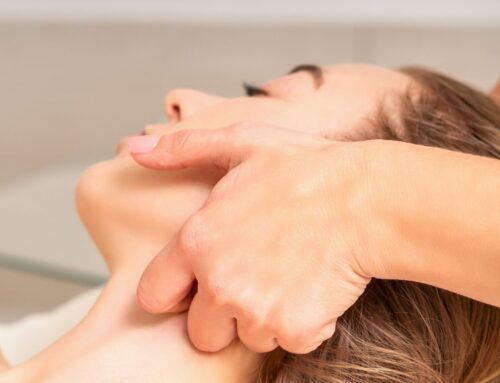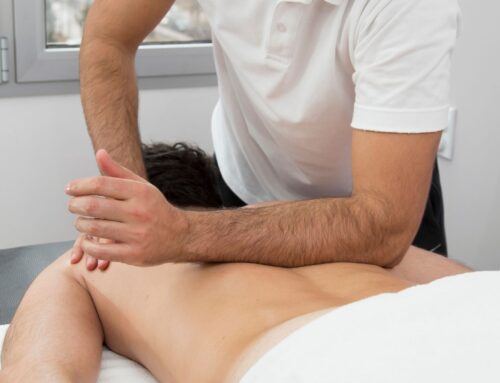Everyone knows someone who has experienced back pain or maybe it is you who suffers with this common affliction. It is so widespread that low back pain is the most common musculoskeletal problem globally.[i]
It is the leading cause of activity limitation and the most common reason for missing work. The incidence of chronic upper back pain is estimated to be between 15-19% globally. While the lifetime prevalence of low back pain is estimated at 60-70% in industrialized countries.[ii]
While back pain has many causes, myofascial trigger points (MFTPs) are a common source. These sore, stiff, and aching spots within muscles, often referred to as ‘knots’, can cause a surprising amount of pain and without treatment can cause chronic pain and loss of function. Not surprisingly, it is the leading cause of activity limitation and the most common reason for missing work.
This post will explain what the science tells us about myofascial trigger points, some examples of common myofascial trigger points throughout the body that are known to contribute to back pain, and the role that a skilled massage therapist can have in the treatment of your myofascial trigger points.
Table of Contents
- What is myofascial trigger point?
- Classifications of MFTPs
- Why do MFTPs develop?
- Where are MFTPs located?
- How can massage therapy help MFTPs?
What is a Myofascial Trigger Point?
A myofascial trigger point (MFTP) is a hyperirritable spot, usually within a taut band of skeletal muscle, which is painful on compression and can give rise to characteristic referred pain (pain perceived distant to the MFTP location), motor dysfunction (muscle weakness, reduced range of motion, stiffness), and autonomic phenomena (skin redness, sweating, and dizziness).[iii]
While not actually a knot, a MFTP is more like a small area of persistently contracting muscle. Muscles are meant to contract but to remain healthy they must also relax. Surrounding a MFTP, we find a lack of oxygen (ischemia) and proper circulation; a situation that allows for the accumulation of metabolic and inflammatory by-products that in turn causes pain.[iv]
In the presence of a MFTP, the affected muscle can become weakened, fatigue faster, and be less able to lengthen effectively.[v] And in a domino-like effect, other muscles react to this burden by either working harder or becoming inhibited; two states that can lead to the development of more MFTPs.[iv]
You may also enjoy reading: The Benefits of Myofascial Release Massage
Classification of Myofascial Trigger Points
Myofascial trigger points can be classified as primary or satellite, active or latent.[iii]
Primary – Usually located centrally within the muscle belly, causes intense pain with pressure and is accompanied by referred pain
Satellite – Develop in surrounding muscles in response to the primary MFTP. Will disappear once the primary MFTP has been resolved
Active – Causes pain at rest, is accompanied by a characteristic referral pattern or pain radiation and may restrict movement and weaken the muscle
Latent – Does not cause pain at rest, but is tender when palpated and can become active when a muscle is injured, fatigued or strained
You may also enjoy reading: What is Deep Tissue Massage
Why Do MFTPs Develop?
While there is currently no agreement on the exact cause of myofascial trigger points both acute trauma and repetitive micro-trauma are widely considered to contribute to their formation.[vi] The following examples can predispose a muscle group to repetitive micro-traumas:
- Inactivity due to sitting for long periods of time or bedrest
- Sustained loading or overloading of a muscle (i.e. carrying a baby, moving heavy objects, weightlifting)
- Habitually poor posture
- Chronic stress conditions (i.e. anxiety, depression, and trauma)
- Sleep disturbances
- Vitamin deficiencies
- Joint issues
- Aging
You may also enjoy reading: The Benefits of Swedish Massage
Where Are MFTPs Located?
Although not an exhaustive list, myofascial trigger points in the muscles below can contribute to back pain. Recall that MFTPs have characteristic referral patterns, so even though a muscle may not be located in the back it could be referring pain to the back.
Upper and Mid-Back Pain [vii], [viii]
Scalenes – Located in the neck, scalene MFTPs can refer pain to the upper and mid back, between the shoulders and to the chest and down the arm to the wrist, hands, and fingers.
Levator Scapulae – Located in the neck, MFTPs within this long thin muscle refers pain most commonly to the point where the shoulder and neck meet but can also see symptoms radiating to the inside border of the shoulder blade.
Latissmus Dorsi – A large muscle of the back that is integral to many movements of the arms, MFTPs commonly refer a stabbing-like pain to lower inner angle of the shoulder blades.
Rhomboids – Found between the shoulder blades, MFTPs within these muscles often refer pain locally and can be accompanied by crunching and snapping sounds as the shoulder blades move around.
Pectoralis Major – MFTPs within this superficial chest muscle will refer pain between the shoulder blades as well as the chest, front of shoulder and down the arm to the elbow. They are often activated by MFTPs in the middle trapezius muscle.
Middle Trapezius – Prone to developing MFTPs especially in the case of tight chest muscles, MFTPs within this superficial back muscle also refer pain between the shoulder blades.
Low Back Pain [ix]
Quadratus Lumborum – The Quadratus Lumborum is muscle that stretches between the top of the hips and the lowest rib next to the spine. This muscle works hard to stabilize the abdomen and lower back. MFTPs within the QL refer pain to the hips, buttocks, and around the SI joint or at the base of the spine.
Gluteus Medius – A fan-shaped muscle that is key for pelvic stabilizing while walking will refer pain to the low back and SI joint.
Iliopsoas – Working together these two muscles work to flex the hips. MFTPs refer to the low back and medial buttock.
Rectus Abdominus – Located on the front of the body this muscle is the most superficial of the core muscles. Trigger points within the upper region of the rectus abdominus can present as a band of pain across the mid-back and can also feel like heartburn, indigestion, or nausea. Trigger Points within the lower rectus abdominus refer a band of bilateral pain across the low back.
You may also enjoy reading: Thai Massage Services
How Can Massage Therapy Help MFTPs?
Massage therapy for myofascial trigger points (MFTPs) aims to restore balance and function within affected muscles by deactivating MFTPs. Your RMT will be looking for a few characteristic signs when identifying a trigger point – a taut band of muscle, a hypersensitive spot, and referred pain.[x]
When pressure is applied to a MFTP, it is common to see a local muscle twitch response and/or jump sign. Once located, your RMT can use ischemic compression, deep petrissage and stretching to treat the MFTP.
Deactivation of a primary MFTP will often resolve satellite MFTPs in the process. After the treatment you may feel sore initially but then notice a decrease in pain and stiffness and an increase in range of motion in the hours and days following treatment.
Your RMT will also assign appropriate stretches, exercises and adjustments to activities of daily living that that will help to maintain improvements made during your treatment and support the health of your muscles to prevent future MFTPs.
Back pain can be debilitating and greatly affect your everyday life, MFTPs is one condition that is often overlooked and underestimated and can cause mild to severe back pain, limit range of motion and decrease muscle strength. But however tenacious they are, MFTPs are also treatable and registered massage therapists are trained to provide this treatment.
At Propel Physiotherapy our registered massage therapists are trained and experienced in the treatment of low back pain. Call us today to see how we can help get you back to doing what you love.
References
[i] Wu A, March L, Zheng X, Huang J, Wang X, Zhao J, Blyth FM, Smith E, Buchbinder R, Hoy D. Global low back pain prevalence and years lived with disability from 1990 to 2017: estimates from the Global Burden of Disease Study 2017. Ann Transl Med. 2020 Mar;8(6):299. doi: 10.21037/atm.2020.02.175. PMID: 32355743; PMCID: PMC7186678.
[ii] Briggs AM, Smith AJ, Straker LM, Bragge P. Thoracic spine pain in the general population: Prevalence, incidence and associated factors in children, adolescents and adults. A systematic review. BMC Musculoskeletal Disorders. 2009;10:77. doi:10.1186/1471-2474-10-77.
[iii] Simons DG, Travell JG, Simons LS. Travell & Simons’ myofascial pain and dysfunction: The trigger point manual. Baltimore: Williams & Wilkins; 1999. pp. 21–34.
[iv] Bron C, Dommerholt JD. Etiology of myofascial trigger points. Curr Pain Headache Rep. 2012 Oct;16(5):439-44. doi: 10.1007/s11916-012-0289-4. PMID: 22836591; PMCID: PMC3440564.
[v] Ge HY, Arendt-Nielsen L, Madeleine P. Accelerated muscle fatigability of latent myofascial trigger points in humans. Pain Med. 2012 Jul;13(7):957-64. doi: 10.1111/j.1526-4637.2012.01416.x. Epub 2012 Jun 13. PMID: 22694218.
[vi] Alvarez, DJ D.O., Rockwell, PG D.O. Trigger Points: Diagnosis and Management. Am Fam Physician. 2002;65(4):653-661
[vii] Perry, L., Dr. (n.d.). Trigger Point Therapy for Mid Back Pain. Painwhisperer.com. https://www.painwhisperer.com/trigger-point-midback-pain
[viii] Perry, L., Dr. (n.d.). Neck – Upper Back Pain Trigger Points. Painwhisperer.com. https://www.painwhisperer.com/trigger-point-midback-pain
[ix] Perry, L., Dr. (n.d.). Trigger Point Therapy – Sciatica Trigger Points. Painwhisperer.com.
[x] Lebert, R. (2020, June 30). Myofascial Trigger Points – What Are They, Really? Massage Magazine.
Written by








